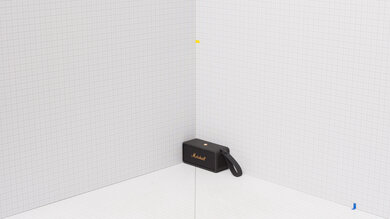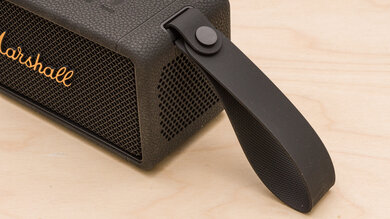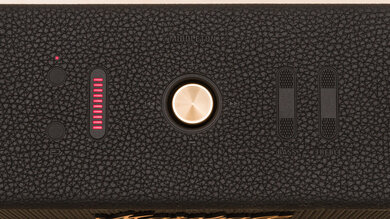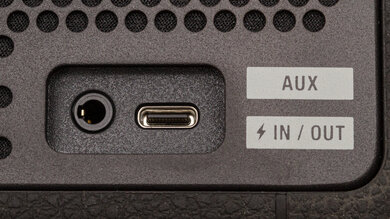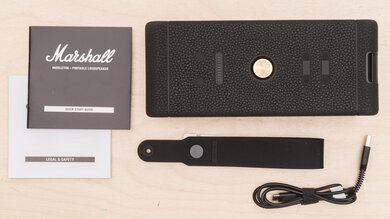The Marshall Middleton is a portable Bluetooth speaker designed in the company's signature guitar-amp style. Its small and lightweight design is ideal if you want to take your favorite tunes with you on the go, and its removable carrying strap lets you carry it in one hand. It has a waterproof and dustproof design, too, with easy-to-use controls to adjust its bass and treble more to your liking. The USB-C port is meant to charge the speaker, but it also functions as an output, letting you use the speaker as a portable charging bank for your other devices.
Our Verdict
The Marshall Middleton is decent for music. This portable Bluetooth speaker is a solid choice for bringing your favorite tunes with you on-the-go, with a clear reproduction of voices and other lead instruments that makes it suitable for many different genres. Bass and treble adjustments give you some control over its sound, too. However, given its small size, this speaker can't quite bring the deep rumble in the low-bass that's common with genres like EDM and hip-hop.
-
Bass and treble adjustments.
-
Loud enough for an average-sized room.
-
Lacks an extended low-bass.
-
Some compression at max volume.
The Marshall Middleton isn't designed for watching movies, but if you want to watch a video on a paired smartphone, it can get the job done. Dialogue is clearly reproduced in the mix, and the adjustable bass and treble let you control the overall sound. That said, even with the bass cranked up all the way, you still can't feel the rumble in action-packed scenes like with a home theater setup. It's loud enough for smaller rooms, but larger spaces like basements are harder to fill with sound.
-
Bass and treble adjustments.
-
Loud enough for an average-sized room.
-
Lacks an extended low-bass.
-
Some compression at max volume.
The Marshall Middleton is very good for podcasts. Dialogue is clear and easy-to-follow right out-of-the-box, which is great for keeping up with your favorite shows. Since it pairs with up to two devices at a time over Bluetooth, you can switch between multiple sources with ease. It's portable enough to bring to different rooms as you listen, and it's loud enough for average-sized rooms. If you're in a larger or more open space, you'll want to stay close to the speaker to hear your shows.
-
Loud enough for an average-sized room.
-
Bluetooth pairing with up to two devices at once.
-
Some compression at max volume.
The Marshall Middleton speaker doesn't support voice assistants.
The Marshall Middleton is good for outdoor use. It's a portable Bluetooth speaker that's designed to bring on the go, with an IP67 rating for dust and water resistance. While it's on the heavier side for smaller speakers, its removable carrying strap still means that you can carry it in one hand without issue. It lasts a little over seven hours off a single charge, which is great for a day outdoors. It gets loud enough for smaller gatherings. However, it can't quite fill larger, more open backyards with sound.
-
IP67 rating.
-
Removable carrying strap.
-
Not rated for impact resistance.
- 7.2 Music
- 6.5 Videos/Movies
- 7.8 Podcasts
- 3.2 Voice Assistant
- 7.5 Outdoors
Changelog
-
Updated Mar 26, 2025:
We mentioned the Marshall Tufton in the Battery box for users who want a longer battery life.
- Updated Mar 13, 2024: We've updated this review to include the new "Cream" color variant.
- Updated Sep 15, 2023: Added more information about 20v charging in the Battery box. Since the cable included with purchase doesn't support 20v charging, no changes in the test results.
- Updated Apr 05, 2023: Review published.
- Updated Apr 03, 2023: Early access published.
Check Price
Differences Between Sizes And Variants
The Marshall Middleton is available in 'Black/Brass' and 'Cream,' and you can see the label for the model we tested here. If you encounter another version of this speaker, let us know in the comments, and we'll update our review.
Compared To Other Speakers
The Marshall Middleton is another portable Bluetooth speaker that retains the manufacturer's signature design. It's a tad larger than the Marshall Emberton or the Marshall Emberton II, likely because of its quad-speaker setup that's advertised to include two tweeters, two woofers, and two passive radiators. It can also reproduce a more extended low-bass than the Emberton lineup. Plus, its bass and treble adjustments give you a bit more control over its sound. Its USB-C input/output is a nice touch, especially if you want to charge other devices on the go, which you don't find with many speakers on the market. Its battery doesn't last quite as long as the manufacturer's other models.
You can also check out our recommendations for the best-sounding Bluetooth speakers, the best Bluetooth speakers for bass, and the best outdoor speakers.
The Marshall Middleton is a better portable Bluetooth speaker than the Marshall Emberton. Both speakers have a similar design, but the Middleton is a touch larger and can reproduce a more extended low-bass. Plus, it's supported by a companion app, where you find additional features like bass and treble adjustments. It's even rated for dust resistance, unlike the Emberton. However, its battery life isn't quite as long-lasting.
Depending on your listening habits, you may prefer either the Marshall Middleton or the JBL Charge 5. The JBL's battery lasts longer, and its graphic EQ makes it a bit more customizable. However, the Marshall can reproduce a slightly more extended low-bass. It has a better soundstage as well.
The Marshall Middleton is a bit better than the Marshall Emberton II. Both are portable Bluetooth speakers with a similar design, though the Middleton is slightly larger. It can reproduce more bass, and you may find its bass and treble adjustments give you more control over its sound than the Emberton II's presets. That said, its battery doesn't last quite as long.
The Marshall Middleton is the better choice for most users compared to the Marshall Tufton. The Middleton has a more balanced sound, making it a good choice for various music genres and audio content while the Tufton has a bass-heavy sound some users may also prefer. When it comes to soundstage performance, the Middleton has the edge—it sounds more consistent from various listening angles. It's also rated IP67 for water and dust resistance, which means it can handle a trip to the beach or a fall into the pool. The Tufton is rated IPX2, so it can only manage a little rain. That said, the Tufton has a much longer battery life, and it gets louder than the Middleton.
The Sony SRS-XE300 and the Marshall Middleton are both portable Bluetooth speakers with similar performances. The Sony is the more versatile of the two since it supports voice assistants, unlike the Marshall. It has a graphic EQ, giving you more control over its sound than the Marshall's bass and treble adjustments. Plus, its battery lasts longer, and it's rated for impact resistance. That said, some users may prefer the Marshall's retro design. The Marshall has a better soundstage, too.
Test Results
The Marshall Middleton retains the manufacturer's signature guitar-amp style, much like the Marshall Emberton. It's all-black with the company's logo in gold lettering on the front of the speaker, and there's a removable carrying strap attached. There's also a 'Cream' variant, which features gold accents on the front grille. The controls are on top. It's bigger than the Emberton but remains portable overall.
Though this speaker is a little bigger than the Marshall Emberton, it's still very easy to bring on the go. Since it's battery-powered, you can take it outside without plugging it into a power outlet. Though it's a little heavy, most people can carry it with one hand. The removable carrying strap also helps in this regard.
This speaker has a very good build quality. Since it's meant for outdoor use, it's rated IP67 for dust and water resistance. This means it's certified dust-tight, and you can immerse it in up to a meter of water for thirty minutes. Its plastic build seems solid and sturdy overall, and the metal grilles in front help to protect the drivers inside. That said, the manufacturer says to avoid dropping it.
The controls are on top of the speaker, and they're very easy to use. You have bass and treble adjustments, a Bluetooth button, and a Battery button. There's some feedback to help you keep track of certain levels, too. On the top left of the speaker, you see a light indicator that shows the volume, battery, or bass and treble levels. There are audible chimes when you power the speaker on/off or connect over Bluetooth. That said, the speaker doesn't tell you when you've reached min or max volume.
Plus, the central knob lets you control many different aspects of your listening experience:
- Press once: Plays/pauses audio.
- Move it forward: Skips to the next track.
- Move it backward: Skips to the previous track.
- Move it up: Increases the volume.
- Move it down: Decreases the volume.
- Hold it forward: Fasts-forward the track.
- Hold it backward: Rewinds the track.
The Marshall Middleton has decent frequency response accuracy. It's a little bigger than both the Marshall Emberton and the Marshall Emberton II, so it's not a surprise that it can reproduce a touch more bass than both of these speakers. Still, you don't get as much rumble in the low-bass as with larger devices like the Denon Home 350. Overall, its sound is pretty balanced, and voices and other instruments are clear in the mix. The adjustable bass and treble levels give you some control over its performance.
This speaker has a fantastic soundstage. According to the manufacturer, it uses Marshall's True Stereophonic technology to reproduce a multi-directional stereo sound. In practice, this means instruments are localized to the left and the right as intended in the mix. Its soundstage is perceived as wide and spacious-sounding overall.
This speaker gets loud enough to fill average-sized rooms with sound. However, given its smaller size, it's not a surprise that it's not as ideal for listening in larger spaces. There's some compression present when you push it to max volume, too. If you want a louder sound, you can purchase multiple models and pair them together using the manufacturer's party mode feature, which they call Stack Mode.
Though it's advertised to last over 20 hours off a single charge, this speaker lasted a little more than seven hours in our tests. It's still enough for most listening sessions, and your real-world experience may vary a bit depending on your usage habits, like the volume level. Plus, the speaker shuts off after twenty minutes without an audio connection, which helps to conserve the battery. The manufacturer advertises a quick-charge feature to give you two hours of playtime from twenty minutes of charging time. Marshall contacted us directly to inform us that the device charges faster with a supported 20v charger and cable. It's true, as our tests confirmed that the speaker charges in 2.2 hours with this setup. However, the charging cable that comes with the speaker doesn't support 20v charging, so if you use that, expect a charge time of around 3.7 hours instead. If you want a speaker from the same manufacturer with a longer battery life, check out the Marshall Tufton, which lasts 17 and a half hours on a single charge.
The Marshall Bluetooth app lets you control some of the speaker's functions from your phone and other mobile devices. As you can see from the video here, it lets you adjust the bass and treble. Also, you can connect it with other compatible speakers to spread sound throughout a larger area using its Stack Mode.
The 3.5mm AUX port lets you wire older devices to the speaker for audio playback. Plus, the USB-C port acts as both an input and an output, so you can either charge your speaker or use the speaker to charge another device.
You can pair this speaker with up to two devices at once over Bluetooth. With its great range, it stays connected to your mobile devices, even if they're further away. Latency is relatively low, so if you watch videos, you don't notice lip-synching issues.
Comments
Marshall Middleton: Main Discussion
Let us know why you want us to review the product here, or encourage others to vote for this product.
- 21010
Ninja telephone support states that this model..BL642 is no longer being manufactured…. discontinued….Why Buy it then…? Even if you get a 1 year warranty….. Just consider a newer… current production model…!



